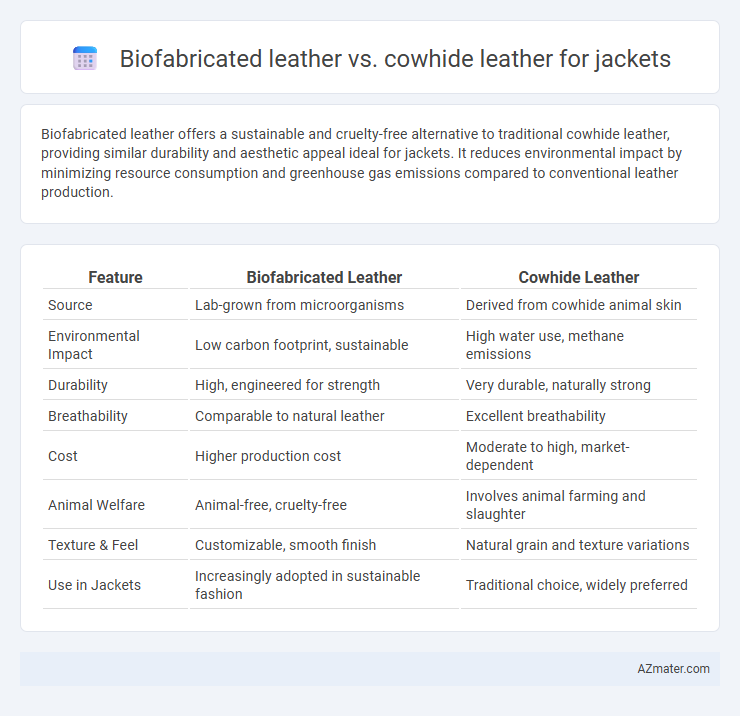Biofabricated leather offers a sustainable and cruelty-free alternative to traditional cowhide leather, providing similar durability and aesthetic appeal ideal for jackets. It reduces environmental impact by minimizing resource consumption and greenhouse gas emissions compared to conventional leather production.
Table of Comparison
| Feature | Biofabricated Leather | Cowhide Leather |
|---|---|---|
| Source | Lab-grown from microorganisms | Derived from cowhide animal skin |
| Environmental Impact | Low carbon footprint, sustainable | High water use, methane emissions |
| Durability | High, engineered for strength | Very durable, naturally strong |
| Breathability | Comparable to natural leather | Excellent breathability |
| Cost | Higher production cost | Moderate to high, market-dependent |
| Animal Welfare | Animal-free, cruelty-free | Involves animal farming and slaughter |
| Texture & Feel | Customizable, smooth finish | Natural grain and texture variations |
| Use in Jackets | Increasingly adopted in sustainable fashion | Traditional choice, widely preferred |
Introduction to Biofabricated and Cowhide Leather
Biofabricated leather is an innovative material produced through sustainable cellular agriculture techniques, offering an eco-friendly alternative to traditional animal hides. Cowhide leather, derived from the tanned skin of cows, is known for its durability, natural texture, and classic appeal in jacket manufacturing. Comparing biofabricated and cowhide leather highlights differences in environmental impact, consistency, and ethical considerations in fashion production.
How Biofabricated Leather is Made
Biofabricated leather for jackets is produced using cultured cells derived from animal tissues, grown in controlled bioreactors to form collagen fibers without involving animal slaughter. This process involves nurturing cells on scaffolds where they proliferate and assemble into a leather-like material that mimics the properties of traditional cowhide. The result is a sustainable leather alternative with reduced environmental impact, using biotechnology to replicate the texture and durability of cowhide leather.
Traditional Cowhide Leather Production Process
Traditional cowhide leather production involves a complex, resource-intensive process starting with the slaughter of cattle, followed by curing, soaking, and tanning using chromium or vegetable tanning methods. This process generates significant environmental impact due to water consumption, chemical usage, and greenhouse gas emissions from livestock. In contrast, biofabricated leather is produced through microbial fermentation or plant-based materials, offering a sustainable alternative with reduced ecological footprint and resource demands.
Environmental Impact: Biofabricated vs Cowhide Leather
Biofabricated leather significantly reduces environmental impact by eliminating livestock farming, which is a major source of methane emissions, deforestation, and water consumption. Cowhide leather production involves intensive resource use, including large quantities of water, land, and energy, alongside chemical tanning processes that contribute to toxic waste pollution. Choosing biofabricated leather for jackets supports sustainable fashion by minimizing greenhouse gas emissions and preserving ecosystems compared to traditional cowhide leather.
Durability and Wear: Comparing Jacket Longevity
Biofabricated leather jackets exhibit high durability due to their engineered strength and resistance to cracking, often outperforming traditional cowhide leather in long-term wear. Cowhide leather offers natural toughness and develops a unique patina over time, enhancing aesthetic appeal while maintaining robust wear resistance. Both materials ensure jacket longevity, but biofabricated leather provides consistent durability without the environmental degradation risks associated with animal hide.
Aesthetic and Texture Differences
Biofabricated leather for jackets offers a consistent grain and smooth texture due to its lab-controlled growth, providing a modern, innovative aesthetic that appeals to eco-conscious consumers. Cowhide leather features natural variations and imperfections, creating a classic, rugged look with a distinct tactile richness and durability valued in traditional fashion. While biofabricated leather delivers uniformity and a sleek finish, cowhide's texture evolves with wear, adding character and depth over time.
Cost Analysis: Biofabricated vs Cowhide Jackets
Biofabricated leather jackets typically have higher upfront costs due to advanced production technologies and limited manufacturing scale, whereas cowhide leather jackets benefit from established supply chains and mass production, resulting in lower prices. Long-term cost considerations for biofabricated leather include potential savings from sustainable sourcing and reduced environmental impact, while cowhide jackets may incur costs related to animal husbandry and environmental regulations. Price trends suggest biofabricated leather could become more competitive as innovation and demand increase, narrowing the current cost gap with traditional cowhide jackets.
Ethical Considerations in Leather Choices
Biofabricated leather offers a sustainable alternative to traditional cowhide leather by reducing animal cruelty and minimizing environmental impact through lab-grown materials. Cowhide leather involves raising and slaughtering animals, contributing to ethical concerns over animal welfare and deforestation caused by livestock farming. Choosing biofabricated leather aligns with ethical fashion principles by promoting cruelty-free production and lower carbon footprints in jacket manufacturing.
Market Availability and Brand Adoption
Biofabricated leather, a sustainable alternative to traditional cowhide leather, is gaining traction in niche markets due to limited large-scale production facilities and relatively high costs. Major fashion brands like Adidas and Stella McCartney have begun adopting biofabricated leather in select collections, signaling growing interest but limited mainstream availability. Conversely, cowhide leather dominates the jacket market with widespread accessibility and established supply chains, making it the preferred material for mass-market brands and consumers.
Future Trends in Leather Jacket Manufacturing
Biofabricated leather is poised to revolutionize leather jacket manufacturing by offering a sustainable alternative that reduces environmental impact and animal cruelty. Advances in biotechnology enable precise control over texture and durability, matching or surpassing cowhide leather's performance while allowing for customizable designs. Future trends indicate increasing adoption of biofabricated leather driven by consumer demand for eco-friendly products and regulatory pressures on traditional leather industries.

Infographic: Biofabricated leather vs Cowhide leather for Jacket
 azmater.com
azmater.com